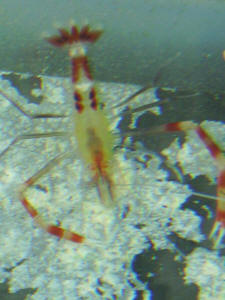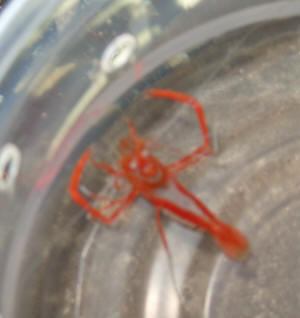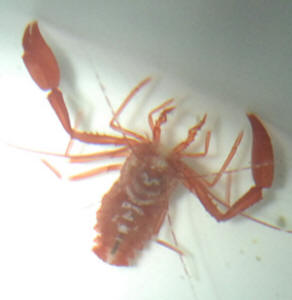|
FAQs about Coral Banded Shrimp, Other Boxers
Identification
Related Articles: Coral Banded
Shrimp,
A Few Common Shrimps for the Marine Aquarium by James W.
Fatherree,
Related FAQs: CBS ID,
Stenopids/Boxer
Shrimps 1, Stenopids/Boxer Shrimps
2 & FAQs on: Stenopid
Behavior, Stenopid Compatibility,
Stenopid Selection, Stenopid Systems, Stenopid Feeding, Stenopid Disease, Stenopid Reproduction, & FAQs on
Coral Banded Shrimp: CBS Behavior,
CBS Compatibility, CBS Selection, CBS
Systems, CBS Feeding, CBS Disease, CBS
Reproduction, Cleaner Shrimp: Cleaner Shrimp Identification, Cleaner Shrimp Behavior, Cleaner Shrimp Selection, Cleaner Shrimp Compatibility, Cleaner Shrimp Systems, Cleaner Shrimp Feeding, Cleaner Shrimp Disease, Cleaner Shrimp Reproduction, Dancing Shrimp, Harlequin Shrimp, Pistol Shrimp, Saron Shrimp, Shrimp Identification, Shrimp Selection, Shrimp Behavior, Shrimp Compatibility, Shrimp Systems, Shrimp Feeding, Shrimp Reproduction, Shrimp Disease, Crustacean Identification,
Crustacean Selection, Crustacean Behavior, Crustacean Compatibility, Crustacean Systems, Crustacean Feeding, Crustacean Disease, Crustacean Reproduction,
|

|
|
Fountain Shrimp? Possibly Stenopus earlei -
5/26/09
<Hello Doran, Lynn here this afternoon.>
I recently got this shrimp. It was in with some Fountain Shrimp,
and was sold to as such. However its coloring is very different
then what I am used to seeing on Fountain Shrimp.
<Yes it is, it's reversed. Where the typical Fountain
Shrimp/Ghost Boxing Shrimp (Stenopus pyrsonotus) is white, this
one is red and vice versa. The good news is that I've found
photos of what appears to be the same shrimp, identified as
Stenopus earlei. The bad news is that all of the photos are from
one site only (a Japanese dive site). I've looked through
every search engine and book I have but have found no
corroborating information to support this ID. The common names
for S. earlei are Earle's Coral Shrimp and the Two stripe
Coral Shrimp and its range is Hawaii/Indo-West Pacific region.
Please see the following photos for comparison:
http://www.ishigaki-diving.com/photo/029.html
http://www.ishigaki-banana.com/3diary/diary_images/B2007_05/052617.jpg >
Also I am fairly certain that it is female, as it was holding
eggs when I got it.
<Neat>
Photo is attached.
<Thanks>
Doran
Vancouver, WA
<Take care, Lynn (Everett, WA)>
|
 |
|
Help with Shrimp Identification: Microprosthema sp. -
1/23/08 Hey gang! <Hi there! What can I do for you this
evening?> First of all, WONDERFUL site! If I ever have a
question about anything tank related, I can pretty much count on
the answers being found in the depths of your site! <Why thank
you! I know what you mean. It's always the first place I go
to when looking for information.> Now, to the question at
hand. I realize that there are literally thousands of different
types of shrimp and crabs, but I am trying to identify one in
particular. It is an almost solid red shrimp with claws similar
to that of a boxer (coral banded shrimp). <That's an
excellent observation. Your shrimp is related to these.> The
body is a bit different though, as it is much shorter. I have
looked through numerous books and Googled till my fingers were
numb, but have gotten nowhere. It was captured, photographed and
released during a dive in south/central Florida. I have seen them
a few times while diving, but they have not been as numerous
CBS's and peppermint shrimp. No one can seem to identify this
guy. Any ideas? <Yes, indeed! It's a shrimp in the genus
Microprosthema, possibly Microprosthema semilaeve/aka the
"Crimson Coral Shrimp", and a little beauty at that!
The reason it reminds you of a CBS is for good reason as both are
in the same family: Stenopodidae. Unfortunately, there's not
a whole lot of photographic documentation of these shrimp on the
internet, but I did find a few photos for comparison (of M.
semilaeve). The first link has great detail, but the color looks
off. The second is of the same species, with what appears to be a
more likely color.
http://striweb.si.edu/bocas_database/details.php?id=2533
http://www.nhm.org/guana/bvi-invt/bvi-surv/images/shri-i01/vc1105p.htm
> Thanks again for all you guys do, -wuf <You're very
welcome and thank you! That's a neat little shrimp! Take care
--Lynn>
Re: Help with Shrimp Identification:
Microprosthema sp. - 1/24/08 WOW..... <Hi!> I have to
say I am impressed that you were able to track that little
critter down, much less identify it! I searched the scientific
name and STILL couldn't find a photo of it! Not sure where
you were able to find these picts, but I'm glad you could
help me out. <It was a real pleasure. The few photos I found
were thanks to Google Image search, as well as several other
search engines (using the 'Image' category). There's
just not a whole lot of photo documentation out there. That's
why I was so glad that you'd written us and included a
photo!> So, does anyone know if a Microprosthema semilaeve/aka
the "Crimson Coral Shrimp" is reef safe?! (just
kidding!) <Heee! You just had to ask that, didn't you!
<g> Actually, I would guess that they're similar to
other Stenopids -- territorial, aggressive towards other
crustaceans, but otherwise a neat little shrimp.> Best,
-Wuf
<Take care. -Lynn>
|
|

|
Yellow/Gold Coral Banded shrimp Stenopus scutellatus
5/19/03 Hi, Thanks for your response. I think I have
found the species:
http://www.liveaquaria.com/product/prod_Display.cfm?siteid=23&pCatId=685
Yellow banded Coral Shrimp <Stenopus scutellatus> Can I still
assume that he is likely to be a danger to the fire shrimp as he gets
larger. <indeed to any small clawed shrimp... although this species
is rather reclusive... even for a boxing shrimp> He is about 1/2 his
full size at the moment and is causing no problems, much less
aggressive than the fire shrimp themselves. I have a 50G tank with
plenty of live rock i.e. hiding places, caves etc Should I take him
back or wait and watch? Cheers, John <its a tough call, John. I
would have never recommended it or tried it personally. Who's to
say what will happen down the road. I am somewhat concerned for
long-term prospects as the tank is only big enough for one shrimp's
natural territory. I'd feel a lot safer to sit back and observe if
the aquarium was larger/longer. Still... you have the best position to
make a decision in actual observance of the behavior of these
particular individuals... by day at least. In the US, both of these
shrimps are uncommon and expensive. My advice would be to play it safe
and separate them... although do not move the new shrimp so soon (days
) after purchase... too many moves since import could stress and kill
it anyway. Kind regards, Anthony>
Re: Coral Banded Shrimp ID 7/15/06 Thanks for the
information guys. <<Did it help?>> I had read the links you
gave, but was not able to determine which based on what was there.
<<Guess not <grin> >> I finally did end up just
trying to look up a listing with picture for all of the Stenopus
species. Luckily there are not too many. I
finally found a page on reefcorner.org that listed species and a brief
description. While this main page is in another country, it
did give me a scientific name that I could search with, and found a
picture of on another site. It looks almost exactly like the
Stenopus cyanoscelis shown. <<"Almost"...but?>>
Now I just need to find some more detailed information regarding this
subspecies. I would guess based on how hard it was to find
any information specific to this shrimp that he is fairly rare or just
not brought into the hobby. I did find that there must be
similar species if not the same that occurs in Australia because of
re)description regarding the Stenopus cyanoscelis and a new Stenopus
chrysexanthus. If you know where I can find more specific
information regarding these, please let me know. <<I just did
some looking around and based on your earlier description, what you
have might be Stenopus scutellatus. Take a look here and see
what you think: http://www.liveaquaria.com/product/prod_Display.cfm?pCatId=685
>> Thank you in advance. Chuck Davis <<Regards, Eric
Russell>>
Re: Coral Banded Shrimp ID, Help! Stenopus
cyanoscelis 7/15/06 Bob, I'm struggling to provide/find
any real info (in English, anyway) to help this guy out. Can
you CC Helmut Debelius re to see if he can/would help? Eric
<Will cc Helmut... but this is a valid species: http://www.google.com/search?q=stenopus+cyanoscelis> Coral
Banded Shrimp ID III - 07/16/06 Eric, <<Chuck>> I looked at
the picture you had on Live Aquaria. I had looked at
it previously, but in the description, it very specifically says it has
yellow legs. The reason I stated before that it
"almost" looked like the ones I have, was due to the fact,
you are trying to compare a picture to an individual, and because the
one I have is very small also. <<Indeed...and obviously, you are
in a better position to make the call>> I have included a link to
the picture I found of it http://www.meerwasser
lexikon.de/de/55/839/Stenopus/cyanoscelis.htm and also of the one that
refers to them as the blue leg boxer shrimp http://www.reefcorner.org/species/family.asp?FAMILY_ID=159
<<Mmm, yes...quite similar but for the
"legs". Too bad none of these sites offer
"multiple language" translations>> Thank you in
advance, Chuck Davis <<Doesn't look like I'm helping you
much here Chuck, you obviously have searched out well what little info
there seems to be. I'll ask Bob if maybe he can CC
Helmut Debelius and see if we can get some information re this species
(Stenopus cyanoscelis). EricR>> <There are a few
other similar-appearing Stenopid species... Bob Fenner>
|
Gold or yellow CBS? Gold (Stenopus scutellatus) 12/06/2007
Hello crew! <Hi Danny! Mich with you today.> I recently
moved my tank (4 months ago) without any incident thanks to
information on this site. <Great to hear!> Before doing so,
I sold my shrimp back to the LFS--I feared they are so sensitive
they couldn't handle the transport. Anyway, today I purchased
a coral banded shrimp. It was mislabeled as a "plain"
CBS for $11 but I quickly recognized it was a little different
because of the yellow-gold body. Of course I pointed out the
error, but was still given the $11 price, as I frequent the store
often. <Lucky you!> So, the guy told me it was a gold CBS
(zanzibaricus). Naturally, I went online to try and confirm it
while Mr. Shrimp was getting the drip treatment and behold there
is also another Stenopus that looks similar called a yellow CBS
(scutellatus). <Yes.> My shrimp is only about an inch at
most across, little guy. The yellow is mostly on the upper part
of the body, the claws and abdomen are banded red and white
(attached a pic). <Is a Golden coral shrimp (Stenopus
scutellatus), which can be differentiated from Stenopus
zanzibaricus by the antennae, the former being long and white,
the latter being red.> I could not find a description that
differentiated the gold from the yellow nor if there was any
significant difference in size or behavior...can you? I know
whether it is gold or yellow seems silly, but it's important
to me that I can properly identify my friends! <All about the
bragging rights, eh?> The tank is 45 gallons, has about 40lbs
of live rock, and about 5" deep layer of aragonite
substrate. I have 192 watts of PC lighting and a Remora skimmer.
Temp 78-80, ph 8.2, ammonia 0, nitrites 0, and nitrates 10ppm.
<Zero is better.> Inhabitants include: 2 ocellaris clowns,
1 black-capped Basslet, 1 black-tail humbug, <Yikes... can
grow up to be big bad boys!> 1 yellow tail damsel, 2 small
blue hermit crabs, and a Hawaiian feather duster. Also, I have a
handful, perhaps two handfuls, of Stomatellids and Nerites that
hitchhiked on my live rock and survived the move. <You're
having some pretty good luck here, though the Stenopus may find
them tasty!> Thanks for your help in advanced!
<Welcome!> Danny N. <Mich L.> Tampa, FL
<Gouldsboro, PA... but visiting your fine state soon!>
Re: Gold or yellow CBS? Gold (Stenopus scutellatus)
12/07/2007 Hello Mich! <Hi Danny!> Thank you for the
reply; <Welcome!> however, I am a little confused.
<Heehee! My normal state...> So I definitely have a
scutellatus, right? <Yes, white antennae = scutellatus.>
The confusion is because of those pesky common names,
<That's why it is always better to use scientific names,
both genus and species...> as I have read that scutellatus is
usually referred to as a yellow CBS and zanzibaricus as the gold
CBS. <I have seen the names used interchangeably... with both
species... Makes things nice and clear... eh?> Scutellatus is
a little bit smaller out of the commonly offered CBS too from
what I found. <Just don't try to keep him with any other
CBS.> The humbug I have is actually kept in check by both the
clowns for the moment. <Hmmm, sounds temporary...> I expect
when she gets bigger, the tables might turn-- <Very well
may...> at that point I will fetch her out of the tank!
<Good luck with that!> Thank you again <Quite welcome,
Danny!> and have a great visit here, <Thank you! I do hope
it is most enjoyable.> the weather is great! <Well, it
doesn't take much to beat the 6 degree F temperatures and
snow that was in the Pocono Mountains this a.m.! Mich>
Danny
Tampa, FL
|
|

|
|
|

